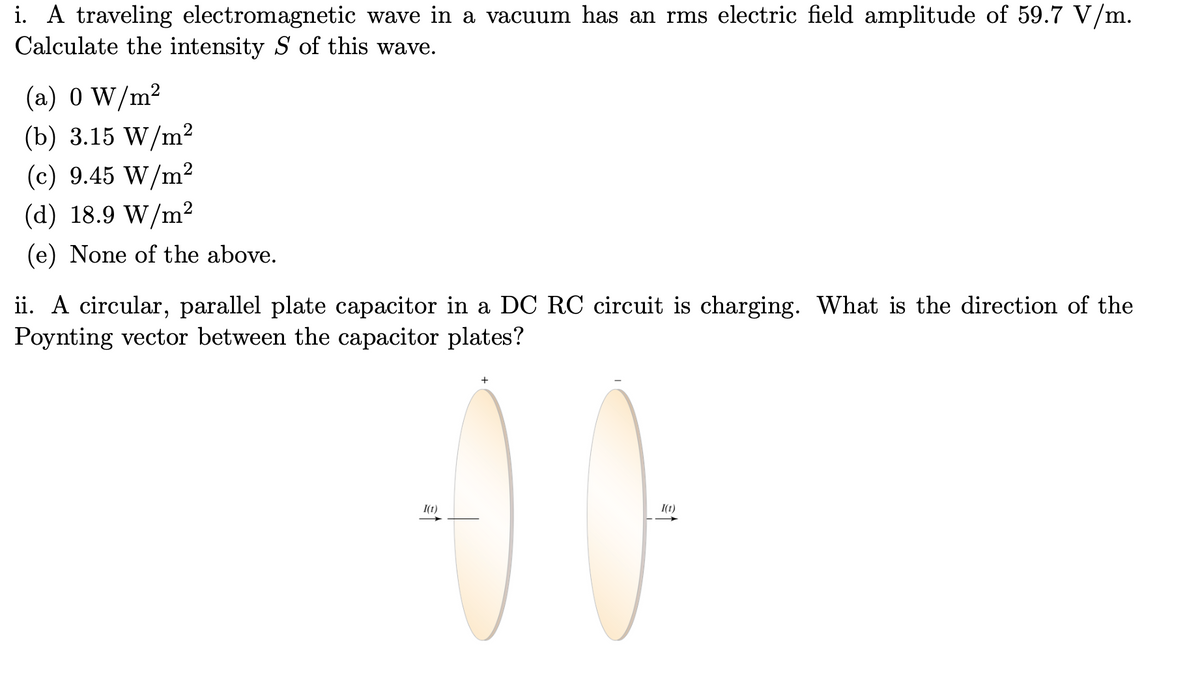i. A traveling electromagnetic wave in a vacuum has an rms electric field amplitude of 59.7 V/m. Calculate the intensity S of this wave. (a) 0 W/m² (b) 3.15 W/m² (c) 9.45 W/m² (d) 18.9 W/m² (e) None of the above. ii. A circular, parallel plate capacitor in a DC RC circuit is charging. What is the direction of the Poynting vector between the capacitor plates?
i. A traveling electromagnetic wave in a vacuum has an rms electric field amplitude of 59.7 V/m. Calculate the intensity S of this wave. (a) 0 W/m² (b) 3.15 W/m² (c) 9.45 W/m² (d) 18.9 W/m² (e) None of the above. ii. A circular, parallel plate capacitor in a DC RC circuit is charging. What is the direction of the Poynting vector between the capacitor plates?
Physics for Scientists and Engineers, Technology Update (No access codes included)
9th Edition
ISBN:9781305116399
Author:Raymond A. Serway, John W. Jewett
Publisher:Raymond A. Serway, John W. Jewett
Chapter34: Electromagnetic Waves
Section: Chapter Questions
Problem 34.11OQ
Related questions
Question
-
i. A traveling
electromagnetic wave in a vacuum has an rms electric field amplitude of 59.7 V/m.Calculate the intensity S of this wave.
(a) 0 W/m2 (b) 3.15 W/m2 (c) 9.45 W/m2 (d) 18.9 W/m2
(e) None of the above.
ii. A circular, parallel plate capacitor in a DC RC circuit is charging. What is the direction of the Poynting vector between the capacitor plates?

Transcribed Image Text:i. A traveling electromagnetic wave in a vacuum has an rms electric field amplitude of 59.7 V/m.
Calculate the intensity S of this wave.
(a) 0 W/m²
(b) 3.15 W/m²
(c) 9.45 W/m²
(d) 18.9 W/m²
(e) None of the above.
ii. A circular, parallel plate capacitor in a DC RC circuit is charging. What is the direction of the
Poynting vector between the capacitor plates?
I(t)
00
I(t)
Expert Solution
This question has been solved!
Explore an expertly crafted, step-by-step solution for a thorough understanding of key concepts.
This is a popular solution!
Trending now
This is a popular solution!
Step by step
Solved in 2 steps with 2 images

Knowledge Booster
Learn more about
Need a deep-dive on the concept behind this application? Look no further. Learn more about this topic, physics and related others by exploring similar questions and additional content below.Recommended textbooks for you

Physics for Scientists and Engineers, Technology …
Physics
ISBN:
9781305116399
Author:
Raymond A. Serway, John W. Jewett
Publisher:
Cengage Learning

Principles of Physics: A Calculus-Based Text
Physics
ISBN:
9781133104261
Author:
Raymond A. Serway, John W. Jewett
Publisher:
Cengage Learning


Physics for Scientists and Engineers, Technology …
Physics
ISBN:
9781305116399
Author:
Raymond A. Serway, John W. Jewett
Publisher:
Cengage Learning

Principles of Physics: A Calculus-Based Text
Physics
ISBN:
9781133104261
Author:
Raymond A. Serway, John W. Jewett
Publisher:
Cengage Learning


Physics for Scientists and Engineers: Foundations…
Physics
ISBN:
9781133939146
Author:
Katz, Debora M.
Publisher:
Cengage Learning

College Physics
Physics
ISBN:
9781938168000
Author:
Paul Peter Urone, Roger Hinrichs
Publisher:
OpenStax College

Physics for Scientists and Engineers
Physics
ISBN:
9781337553278
Author:
Raymond A. Serway, John W. Jewett
Publisher:
Cengage Learning